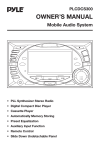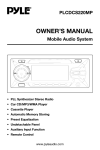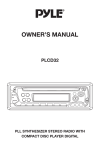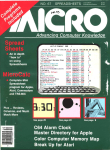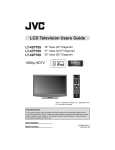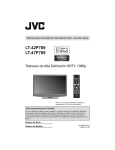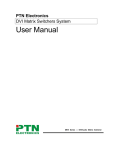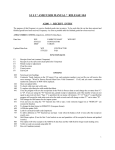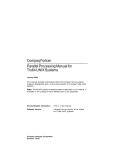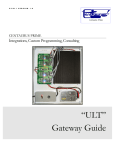Download Radio Shack PLCDCS 200 User's Manual
Transcript
PLCDCS 200 OWNER’S MANUAL Mobile Audio System • PLL Synthesizer Stereo Radio • Digital Compact Disc Player • Cassette Player • Automatically Memory Storing • Preset Equalization • Auxiliary Input Function • Remote Control • Undetachable Panel CONTENTS Installation .....................................................................................................3 Wiring Connection ........................................................................................4 4 x 50W System......................................................................................................4 Operation .......................................................................................................5 General Operation ..................................................................................................6 Radio Operation......................................................................................................7 Cassette Operation.................................................................................................7 CDP Operation........................................................................................................8 Remote Control.......................................................................................................8 Specifications................................................................................................9 Trouble Shooting .........................................................................................10 Maintenance................................................................................................11 Caution.........................................................................................................12 Ignition and Interference Noise .................................................................12 2 INSTALLATION Method A SUB PANEL FLANGE NUT QUICKIE BOLT REAR BUSHING FACTORY BRACKET MOUNTING SCREW QUICKIE BOLT DASH PANEL Method B SUB PANEL QUICKIE BOLT FLANGE NUT MOUNTING SCREW 2#BRACKET DASH PANEL MOUNTING SCREW 2#BRACKET 2#BRACKET 3#BRACKET 1#BRACKET STANDARD MOUNTING CONFIGURATION 2#BRACKET 2#BRACKET “JA” MOUNTING CONFIGURATION 3 “JZ” MOUNTING CONFIGURATION WIRING CONNECTION For 4 x 50W System MAIN UNIT ANTENNA SOCKET IGNITION SWITCH (B+) RED FUSE (BLACK) Rch RED TV AUDIO IN MEMORY BACK-UP GROUND (B–) YELLOW Lch WHITE (GREY) BLACK RCA CABLE Rch RED Lch WHITE POWER ANTENNA FRONT Lch SPEAKER REAR Lch SPEAKER BLUE WHITE GREY WHITE/BLACK GREY/BLACK GREEN VIOLET GREEN/BLACK VIOLET/BLACK 4 FRONT Rch SPEAKER REAR Rch SPEAKER OPERATION 12 16 9 13 10 17 19 4 28 27 20 8 3 15 7 21 18 22 23 11 14 5 24 26 5 1 25 6 2 OPERATION • SELECT MODE Press the MODE button (6) to choose desired listening mode. (e.g. radio, CDP, CDC, tape, TV or AUX mode) GENERAL OPERATION Note: In this product design, there has different sound accompanying with every button pressed and the sound is designed differently according to the customers. • MUTE Press the MUTE button (2) to silence the receiver. Press it again to release the mode. • ON/OFF Switch on the unit by pressing POWER button (9). When system is on, press POWER button (9) again to turn off the unit. • LIQUID CRYSTAL DISPLAY Exhibit current frequency and activated functions on the display (27). • EQUALIZATION Press EQ button (12) to select SOUND EFFECT as shown in below sequence: • OPEN THE FRONT PANEL Press OPEN button (7) to fold down the front panel. NORMAL • SOUND ADJUSTMENT Press PUSH SELECT button (10) to select audio mode shown in the below sequence. VOLUME BASS TREBLE CLAS POP JAZZ Press EQ button (12) over 1 second, graphic display type will display on the LCD and then press TUNE/TRACK/SKIP button (16) or TUNE/TRACK/SKIP button (17) to select graphic display type as follows: BALANCE FADER (For Fader Version Only) By rotating the knob (10) clockwise or counter-clockwise, it is possible to adjust the desired sound quality. If adjustment has not been done in BAS/TRE/BAL/FAD mode, it is returned to the volume select mode (initial) 5 seconds later. Note: Only in fader version, fader is effective. DNCO1 DNCO2 DNCO3 DNCO4 DNCO5 • REMOTE SENSOR Point the remote control handset to the remote sensor IR (23). Press the function keys on the handset to control the system. • AUXILIARY INPUT The unit can be connected to a portable audio player through the AUX IN jack (11). • LOUDNESS Press the LOUD button (3) to loudness function and display will show “LOUD”. Press it again to release this function. • RESET RESET button (28) must be activated with either a ball point pen or thin metal object. The RESET button (28) is to be activated for the following reasons: - Initial installation of the unit when all wiring is completed. - All the function buttons do not operate. - Error symbol on the display. • DISPLAY Press the DSP button (15) can switch between frequency or play time display and clock display. To set clock, hold down DSP button (15) until the clock is shown on display then press TUNE/TRACK/SKIP button (17) to change hours or TUNE/TRACK/SKIP button (16) to change minutes. 6 OPERATION memorized, the seconds Auto Store search continued by Distant state. At the end of Auto Store operation, mode is change to Preset Scan. RADIO OPERATION • BAND SELECTION At radio mode, press BAND button (13) to select the desired band. The reception band will change in the following order: FM1 FM2 FM3 AM1 - Preset Scan Press AS/PS button (14) shortly in radio mode, Preset Scan is started. This operation starts from next preset number and finished at the same preset number of which last channel memory stored. Frequency of preset memory is displayed with blinking for 5 seconds. Press AS/PS button (14) again to release this function. AM2 • STATION SELECTION - Manual Tune Up/Down Repeatedly press the TUNE/TRACK/SKIP button (16) or TUNE/TRACK/SKIP button (17) for manual tuning frequency downward or upward. - Seek Tune Up/Down Press and hold the TUNE/TRACK/SKIP button (16) or TUNE/TRACK/SKIP button (17) for several seconds for auto tuning frequency downward or upward. • STATION STORING Press and release any one of the preset buttons (18) (1 - 6) shortly, (1 - 6) preset memory is called (Preset Call). Press the button for several secnds, current frequency is stored into preset memory and preset number (1 - 6) is displayed (Preset Store). • LOCAL/DISTANT Press LOC button (1) shortly to select between local and distant stations. Local setting for reception of strong station, and a distant setting for reception of weaker stations. In local mode, “LOC” will display. CASSETTE OPERATION • PROGRAM BUTTON These two buttons (25) perform the dual functions of changing the direction of tape playback and fast forward/rewind of the tape. - Change Tape Playback Direction Press both buttons together to play the other side of a tape. - Fast Forward/Rewind Press the button with the double arrows pointing the same direction as the direction indicator in the LCD to fast forward; press other button in the opposite direction to fast rewind. • MONO/STEREO At FM radio mode, press MO/ST button (8) to set the reception between mono mode and stereo mode. In stereo mode, when stereo broadcasting station is received, the “ ” indicator will appear upon the display. • AUTOMATIC MEMORY STORING & PRESET SCAN - Automatic Memory Storing Press AS/PS button (14) over 1 second in radio mode, Auto Store is started. Stations are searched automatically from next frequency and detected station is stored into the preset memory. In case of LOC state, the first Auto Store is done by LOC state and if 6 CH is not fully • EJECT Push the eject button (24) down to eject the cassette tape. • CASSETTE COMPARTMENT Insert a cassette tape into the cassette compartment (26). The cassette mechanism will load it in play mode. 7 OPERATION CDP OPERATION REMOTE CONTROL HANDSET • SELECT TRACKS Press TUNE/TRACK/SKIP button (16) or TUNE/TRACK/SKIP button (17) to move to the previous track or the following track. Track number shows on display. Hold TUNE/TRACK/SKIP button (16) or TUNE/TRACK/SKIP button (17) to fast reverse or fast forward. CD play starts from when you release the button. 1 7 4 3 8 9 6 5 13 2 12 10 11 14 15 • PAUSE PLAYING Press PAU button (19) to pause CD player. Press it again to resume play. • REPEAT THE SAME TRACK Press RPT button (21) to continuously repeat the same track. Press it again to stop repeat. FUNCTION KEYS & CONTROL 1. PWR 2. MUT 3. SEL 4. VOL 5. VOL 6. BND 7. MOD 8. TUNE/SEEK 9. TUNE/SEEK 10.EQ 11.PRESET 12.PAU 13.SCN 14.RPT 15.RND • PREVIEW ALL TRACKS Press SCN button (20) to play first several seconds of each track on the current disc. Press it again to stop intro and listen to track. • PLAY ALL TRACKS Press RND button (22) to play all tracks on CD in random order. Press it again to cancel the function. • EJECT When the front panel is folded down, press eject button (4) to stop CD playing and eject the disc from the disc slot (5). 8 = = = = = = = = = = = = = = = Power Button Mute Button Select Button Volume Up Button Volume Down Button Band Select Button Mode Button Tune/Seek Down Button Tune/Seek Up Button Preset Equalization Button Preset Buttons Pause Button Scanning Button Repeat Button Random Button SPECIFICATIONS GENERAL Power Supply Requirements Chassis Dimensions Loading Impedance Maximum Output Power Current Drain : : : : : DC 12 Volts, Negative Ground 200 mm (W) x 138 mm (D) x 75 mm (H) 4 - 8 Ω per channel 4 x 50 Watts 10 Ampere (max.) CD PLAYER Signal to Noise Ratio Channel Separation Frequency Response : More than 55 dB : More than 50 dB : 20 Hz - 20 KHz CASSETTE PLAYER Tape Speed Fast Forward Time Frequency Response Channel Separation Crosstalk Wow and Flutter : : : : : : 4.76 cm/sec 180 seconds (C-60 type) 50 to 8,000 Hz > 35 dB > 40 dB ≤ 0.35% WRMS Frequency Coverage I.F. Sensitivity (S/N = 30 dB) Image Rejection Stereo Separation : : : : : FM 87.5 to 107.9 MHz 10.7 MHz 3 µV > 45 dB > 30 dB Frequency Coverage I.F. Sensitivity (S/N = 20 dB) AM : 530 to 1710 KHz : 10.71 MHz : 32 dBu RADIO 9 TROUBLE SHOOTING Before going through the check list, check wiring connection. If any of the problems persist after check list has been made, consult your nearest service dealer. Symptom No power. Disc cannot be loaded or ejected. Cassette tape cannot be loaded or ejected. No sound. Sound skips or sound quality is poor. The operation keys do not work. Cause Solution The car ignition switch is not on. If the power supply is properly connected to the car accessory circuits, but the engine is not moving, switch the ignition key to “ACC”. The fuse is blown. Replace the fuse. Presence of CD disc inside Remove the disc in the player, then the player. put a new one. Inserting the disc in reverse direction. Insert the compact disc with the label facing upward. Compact disc is extremely dirty or defective disc. Clean the disc or try to play a new one. Temperature inside the car is too high. Cool off or until the ambient temperature return to normal. Condensation. Leave the player off for an hour or so, then try again. Presence of a cassette tape in the player. Remove the cassette tape in the player, then put in the new one. The temperature in the car is too high. Cool off the inside of the car, then try again. Condensation. Leave the cassette player off for an hour or so, then try again. Volume is in minimum. Adjust volume to a desired level. Wiring is not properly connected. Check wiring connection. The installation angle is more than 30 degrees. Adjust the installation angle to less than 30 degrees. The disc is extremely dirty or defective disc. Clean the compact disc, then try to play a new one. The cassette is defective. Try another cassette. The built-in microcomputer Press the RESET button. is not operating properly Front panel is not properly fixed into due to noise. its place. The radio does The antenna cable is not not work. The connected. radio station automatic The signals are too weak. selection does not work. 10 Insert the antenna cable firmly. Select a station manually. MAINTENANCE 3. Clean the tape head with the cotton swab. For System The following suggestions help you care for the product so that you can enjoy it for years. 1. Keep the product dry. If it does get wet, wipe it dry immediately. Liquids might contain minerals that can corrode the electronic circuits. 4. Clean the capstans and the pinch rollers with the cotton swab. 2. Keep the product away from dust and dirt, which can cause premature wear of parts. 5. Allow the tape head, capstans and pinch rollers to dry before operating. 3. Handle the product gently and carefully. Dropping it can damage circuit boards and cases, and can cause the product to work improperly. 6. Do not touch the tape with your fingers; if it becomes lose, wind it back by twisting a six-sided pencil in the cassette reel. 4. Wipe the product with a dampened cloth occasionally to keep it looking new. Do not use harsh chemicals, cleaning solvents, or strong detergents to clean the product. 5. Use and store the product only in normal temperature environments. High temperature can shorten the life of electronic devices, damage batteries, and distort or melt plastic parts. For Tape Player Periodic cleaning of the tape head and capstan shaft will ensure good reproduction of music and trouble-free operation. Cleaning of the tape head should be done every 20 to 30 hours of operation or when the high tones have become less clear. 1. Use a cassette cleaning cartridge if available. If one is not available, use a cotton swab soaked in isopropyl (rubbing) alcohol. 2. While holding the tape door open, locate tape head to the right of the opening and in the centre of the unit. 11 CAUTION 1. This unit is designed to operate on 12-volts DC, negative ground electrical system only. Do not attempt to install this unit in a vehicle having a positive ground system. 2. You should not touch the high-polished playback head with any metallic or magnetic tools. 3. Your unit has built-in filtering to eliminate most of the noise that might come through the power source. However, with some vehicles, particularly older models, some clicking or other unwanted noise might be present. IGNITION AND INTERFERENCE NOISE Ignition Interference The most common source of noise in reception is the ignition system. This is normally due to the fact that radio is placed relatively close to the ignition system (engine). This type of noise can be easily detected because it will vary in intensity of pitch with the speed of the engine. Radio reception in a moving environment (automobile) is very different from reception in a stationary (home). It is very important to understand the difference. Usually, the ignition noise can be suppressed considerably by using a radio suppression type high voltage ignition wire and suppressor resistor in the ignition system. (Most vehicles employ this wire and resistor but it may be necessary to check them for correct operation.) Another method of suppression is the use of additional noise suppressors. These can be obtained from most CB/Amateur radio or electronic supply shops. AM reception will deteriorate when passing through a tunnel or when passing under high voltage lines. Also, noise can be picked up from passing automobiles. Although AM is subject to environmental noise, it has the ability to be received at great distance. This is due to the fact that broadcasting signals follow the curvature of the earth and are reflected back by the upper atmosphere. FM reception is just the opposite of AM. It is not subject to environmental noise and it does not have the ability to be received at great distances (usually 30 miles). Also, the FM signal can be blocked by tall buildings, mountains, or hills. To reduce the possibility of these problems, ALWAYS FINE TUNE a station, and if possible, set the antenna height to 30 inches. www.pyleaudio.com 88-C1480-02












